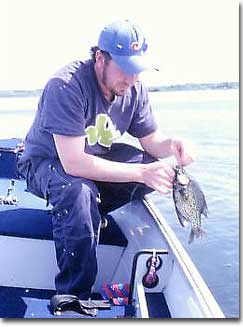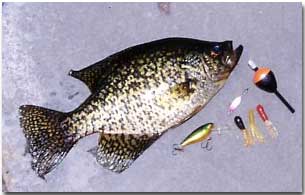Crappies: Scoring BIG on Springtime Slabs
Crappies: Scoring BIG on Springtime Slabs
By Justin Hoffman
As spring slowly makes its appearance, thoughts of opening day crappie waken me from my hibernation and begin to make my pulse quicken. Although their name might be a turn-off, these wonderful little fish have everything an angler could want – they are fairly easy to catch, they’re feisty on ultra-light equipment and they taste delicious in the pan. By understanding their breeding habits, knowing the equipment and techniques needed and by following their locational patterns, this spunky fish with the funny name can share a special place in your heart too. Return to the Shallows Return to the Shallows
As the weather warms, and the ice retreats from northern lakes, crappies begin their migration from the deep offshore areas where they have been suspending to the shallows in search of food. Here the waters start to come alive with crappie feeding on baitfish and insects that occupy the south-facing shores, since these are the first to warm up. This is the best time for shore anglers to get in on the game. Among the favourable spots to find large schools of fish are around man-made boat canals, although boat canal locks and docks are also prime areas. This can make for a relaxing outing, with no boat to worry about and oftentimes, very little fishing pressure. Other crappie will stage at drop-offs outside of bays, periodically returning to the shallows to feed. Shore anglers can pick these fish off if they are there at the right time, although a boat is usually necessary to fish the drop-offs. If weed cover is slow to start, many shallow water crappies will relate to alternate cover, namely sunken trees, brushpiles, stumps or old reeds and cattails. This early migration, or “fake spawn,” usually only lasts a week or two, yet these fish can be intercepted by paying close attention to the conditions and activity. Once this migration has ended, the crappie does an about-turn and disappears for a short period of time. Fishing can be tough during this retreat, since it is a guessing game as to their location, but, due to nature’s way, relief is in sight. Soon the shallows will be teeming with crappies once again, as the mating ritual is about to commence. Spawn Time In most parts of North America, when water temperatures reach 66 to 68 degrees F, crappies begin their spawn. This activity takes place in water that is less than two feet deep. Spawning can range from mid-May to early July, depending on how far north the individual lake is. Here in Southern Ontario it usually occurs in May, however, the temperature is the ultimate deciding factor. During the spawning period, it is best to concentrate on the shallow areas around cover. Again, any section that has a concentration of stumps, fallen timber, boat docks or reeds can be sensational. Individual crappie can spawn at different times of the month, even on the same lake, so usually you will be catching pre-spawn, spawning or post-spawn fish. Outside weed edges or drop-offs away from the shallows will hold many of the post-spawn fish that search for food here once the spawn is complete. The Right Tools for the Job Crappie fishing equipment is quite straightforward and simple. Any light action rod between five and seven-feet is adequate. I, however, opt for an ultra light rod, which provides much greater sensitivity and relays an astounding fight from these scrappy fish. Many people also use long, sensitive steelheading rods that give tremendous reach for placement of your bait. Match your rod with a good quality ultra- light reel, filled with four-to-six-pound-test monofiliment, and you’re set to go.
 Baits for crappie are quite basic as well. During the “fake spawn,” when the water temperature is still cold, and the crappie’s metabolism is slow, live bait is your best bet. A one-to-two-inch minnow suspended under a small float will be all that is needed. Once the water starts to warm, a switch to small tube jigs and twistertail grubs gets the nod. I prefer brightly coloured plastics with white, pink and yellow getting the most action. It is best to suspend these small jigs about six to twelve inches under a float, depending on water depth.
Baits for crappie are quite basic as well. During the “fake spawn,” when the water temperature is still cold, and the crappie’s metabolism is slow, live bait is your best bet. A one-to-two-inch minnow suspended under a small float will be all that is needed. Once the water starts to warm, a switch to small tube jigs and twistertail grubs gets the nod. I prefer brightly coloured plastics with white, pink and yellow getting the most action. It is best to suspend these small jigs about six to twelve inches under a float, depending on water depth. It should be noted that crappies eyes are located on the top of their heads, which enables them to look up to feed, so all baits should be fished in this zone to ensure that the fish can see your offering. I always apply some sort of scent product to my baits as I feel it gives the jig a more tempting quality. Jigs can also be tipped with a small minnow or piece of worm if the fish become really finicky. If the fish are in an aggressive mood, then the use of small spinners or mini crankbaits can pay big dividends. On an outing last spring at Rice Lake, in Southern Ontario, the crappie became so feisty that they where trying to eat my float every time I cast to them! A quick switch to a mini floating crankbait twitched on the surface provided a fast-paced and delightful afternoon. Crappie fishing in the spring is a relaxing and very fulfilling prelude to the summer fishing season. It’s a wonderful way to spend the day with children and family, and once tried, will always have you returning for more. By following the specific breeding and migration patterns, and coupling this with the right equipment and baits, the winter will become just a distant memory, and will leave you wondering why spring doesn’t last all year long.
|
